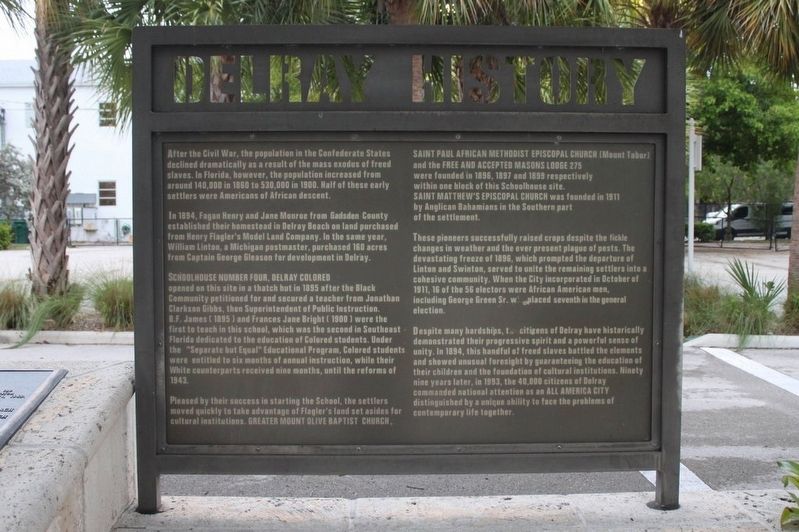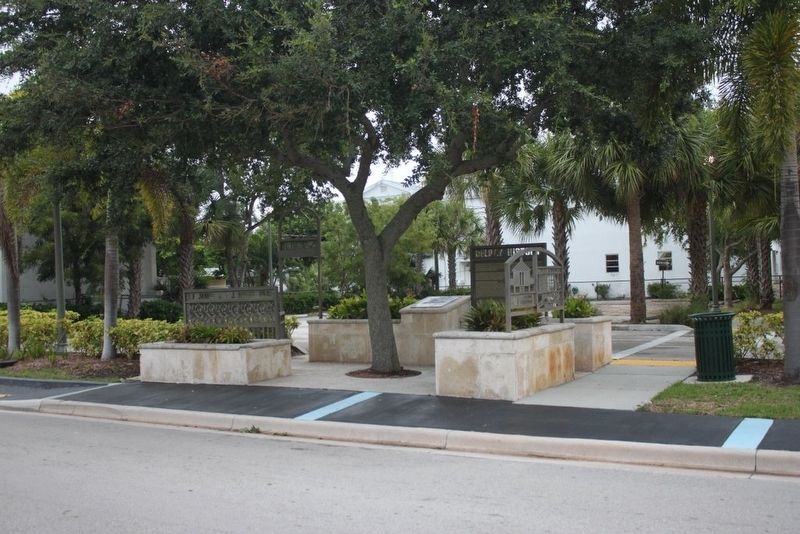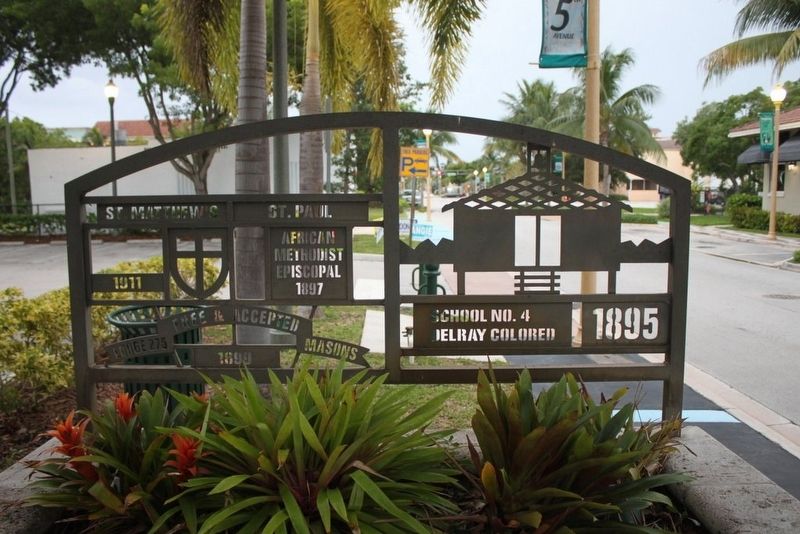Delray Beach in Palm Beach County, Florida — The American South (South Atlantic)
Delray History
In 1894, Fagan Henry and Jane Monroe from Gadsden County established their homestead in Delray Beach on land purchased from Henry Flagler's Model Land Company. In the same year, William Linton, a Michigan postmaster, purchased 160 acres from Captain George Gleason for development in Delray.
Schoolhouse Number Four, Delray Colored opened on this site in a thatch hut in 1895 after the Black Community petitioned for and secured a teacher from Jonathan Clarkson Gibbs, then Superintendent of Public Instruction. B.F. James (1895) and Frances Jane Bright (1900) were the first to teach in this school, which was the second in Southwest Florida dedicated to the education of Colored students. Under the "Separate but Equal" Educational Program, Colored students were entitled to six months of annual instruction, while their White counterparts received nine months, until the reforms of 1943.
Pleased by their success in starting the School, the settlers moved quickly to take advantage of Flagler's land set asides for cultural institutions. Greater Mount Olive Baptist Church, Saint Paul African Methodist Episcopal Church (Mount Tabor) and the Free and Accepted Masons Lodge 275 were founded in 1896, 1897 and 1899 respectively within one block of this schoolhouse site. Saint Matthew's Episcopal Church was founded in 1911 by Anglican Bahamians in the Southern part of the settlement.
These pioneers successfully raised crops despite the fickle changes in weather and the ever present plaque of pests. The devastating freeze of 1896, which prompted the departure of Linton and Swinton, served to unite the remaining settlers into a cohesive community. When the City incorporated in October of 1911, 16 of the 56 electors were African American men, including George Green Sr. who placed seventh in the general election.
Despite many hardships, the citizens of Delray have historically demonstrated their progressive spirit and a powerful sense of unity. In 1894, this handful of freed slaves battled the elements and showed unusual foresight by guaranteeing the education of their children and the foundation of cultural institutions. Ninety nine years later, 1993, the 40,000 citizens of Delray commanded national attention as an All American City distinguished by a unique ability to face the problems of contemporary life together.
Erected by
City of Delray Beach.
Topics and series. This historical marker is listed in these topic lists: African Americans • Churches & Religion • Industry & Commerce • Settlements & Settlers. In addition, it is included in the African Methodist Episcopal (AME) Church series list.
Location. 26° 27.78′ N, 80° 4.685′ W. Marker is in Delray Beach, Florida, in Palm Beach County. Marker is on Northwest 5th Avenue, 0.1 miles north of West Atlantic Avenue (State Road 806), on the right when traveling north. Touch for map. Marker is in this post office area: Delray Beach FL 33444, United States of America. Touch for directions.
Other nearby markers. At least 8 other markers are within walking distance of this marker. City of Delray Beach (here, next to this marker); West Settlers Historic District (within shouting distance of this marker); a different marker also named West Settlers Historic District (approx. 0.2 miles away); Cason Cottage (approx. 0.3 miles away); Florida East Coast Railway Station (approx. half a mile away); Old School Square Historic District (approx. half a mile away); Del-Ida Park Historic District (approx. 0.6 miles away); Marina Historic District (approx. 0.8 miles away). Touch for a list and map of all markers in Delray Beach.
Credits. This page was last revised on August 15, 2016. It was originally submitted on August 14, 2016, by Tim Fillmon of Webster, Florida. This page has been viewed 412 times since then and 20 times this year. Photos: 1, 2, 3. submitted on August 14, 2016, by Tim Fillmon of Webster, Florida. • Bernard Fisher was the editor who published this page.


